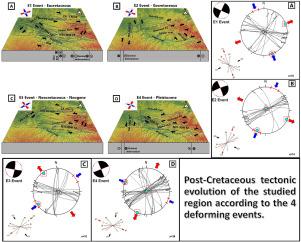副沉积盆地内部的后白垩世跨流板内构造:变形事件和水系的构造控制
IF 1.5
4区 地球科学
Q3 GEOSCIENCES, MULTIDISCIPLINARY
引用次数: 0
摘要
帕拉纳本文章由计算机程序翻译,如有差异,请以英文原文为准。

Transcurrent Post-Cretaceous intraplate tectonics in the interior of the Paraná Sedimentary Basin: deformation events and structural control of drainage network
The central channel of the Paraná Basin is bathed by two important tributaries of the left bank of the Paraná River: the Ivaí and Piquiri rivers. Some tributaries of this region are aligned with fault zones inherited from the basement, suggestively reactivated during and after the Cretaceous, during which the last phase of sedimentation within the basin occurred. Some drainage anomalies, in turn, are indicative of reactivation until the Pleistocene, when the last rearrangement of the drainage network took place. However, models of post-Cretaceous tectonic evolution in the basin do not allow these relationships to be precisely established. To fill this gap, we propose a model of tectonic evolution of the central portion of the Paraná Basin. The structural and tectonic analysis were derived from the survey of the types of faults that presented kinematic indicators in four quarries within the region, where most of the faults are transcurrent and have high angle and low dip grooves and steps. This analysis demonstrated that the region was affected by up to four deforming events from the Cretaceous. The four events present sub-horizontal SHmax and pure to transtensional shear, the most recent being defined from the Pleistocene, with SHmax oriented in N67W. These events had important significance in the control of some rivers in the region. The E4 (Pleistocene) event was responsible for the dextral reactivation of N60-70E (Guaxupé direction) and N70-90W faults, and the sinistral faults with N0-30W and N30-60W directions. Associated with these faults are lineaments affecting the alluvium in the meandering belt of the Goio-Erê River, deformations in the bedrock in the Piquiri River, associated with the nucleation of the drainage anomaly called “the squeeze” in Formosa do Oeste (PR), the generation of failed dikes in the Curitiba-Maringá Fault Zone, in addition to records of deformations in Quaternary sediments of the Paraná River and in sandstones of the Marília Formation (SP).
求助全文
通过发布文献求助,成功后即可免费获取论文全文。
去求助
来源期刊

Journal of South American Earth Sciences
地学-地球科学综合
CiteScore
3.70
自引率
22.20%
发文量
364
审稿时长
6-12 weeks
期刊介绍:
Papers must have a regional appeal and should present work of more than local significance. Research papers dealing with the regional geology of South American cratons and mobile belts, within the following research fields:
-Economic geology, metallogenesis and hydrocarbon genesis and reservoirs.
-Geophysics, geochemistry, volcanology, igneous and metamorphic petrology.
-Tectonics, neo- and seismotectonics and geodynamic modeling.
-Geomorphology, geological hazards, environmental geology, climate change in America and Antarctica, and soil research.
-Stratigraphy, sedimentology, structure and basin evolution.
-Paleontology, paleoecology, paleoclimatology and Quaternary geology.
New developments in already established regional projects and new initiatives dealing with the geology of the continent will be summarized and presented on a regular basis. Short notes, discussions, book reviews and conference and workshop reports will also be included when relevant.
 求助内容:
求助内容: 应助结果提醒方式:
应助结果提醒方式:


